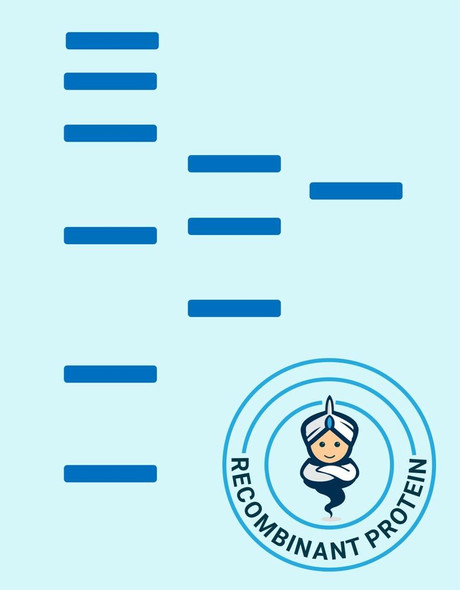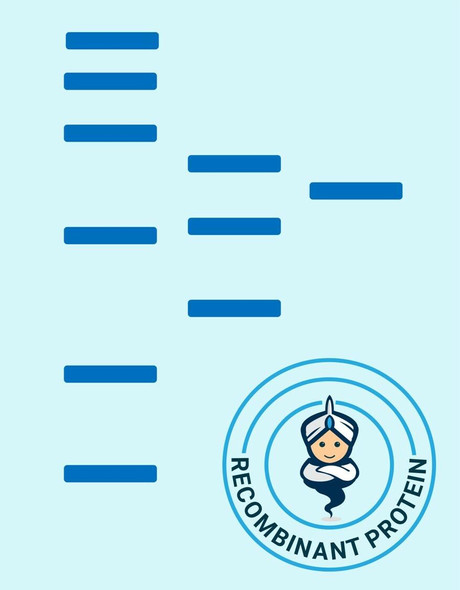Human NAP 2 Recombinant Protein (RPPB1232)
- SKU:
- RPPB1232
- Product type:
- Recombinant Protein
- Size:
- 10ug
- Species:
- Human
- Target:
- NAP 2
- Synonyms:
- Platelet basic protein
- PBP
- Small inducible cytokine B7
- CXCL7
- Source:
- Escherichia Coli
- Uniprot:
- P02775
Description
| Product Name: | Human NAP 2 Recombinant Protein |
| Product Code: | RPPB1232 |
| Size: | 10µg |
| Species: | Human |
| Target: | NAP 2 |
| Synonyms: | Platelet basic protein, PBP, Small inducible cytokine B7, CXCL7, Leukocyte-derived growth factor, LDGF, Macrophage-derived growth factor, MDGF, pro-platelet basic protein (chemokine (C-X-C motif) ligand 7), TC1, TC2, TGB, TGB1, B-TG1, CTAP3, NAP-2, SCYB7, THBGB, LA-PF4, THBGB1, Beta-TG, CTAPIII, CTAP-III. |
| Source: | Escherichia Coli |
| Physical Appearance: | Sterile Filtered White lyophilized (freeze-dried) powder. |
| Formulation: | The CXCL7 protein was lyophilized from a concentrated (1mg/ml) sterile solution containing no additives. |
| Solubility: | It is recommended to reconstitute the lyophilized Neutrophil Activating Protein-2in sterile 18M?-cm H2O not less than 100µg/ml, which can then be further diluted to other aqueous solutions. |
| Stability: | Lyophilized NAP-2 although stable at room temperature for 3 weeks, should be stored desiccated below -18°C. Upon reconstitution CXCL7should be stored at 4°C between 2-7 days and for future use below -18°C. For long term storage it is recommended to add a carrier protein (0.1% HSA or BSA).Please prevent freeze-thaw cycles. |
| Purity: | Greater than 98.0% as determined by:(a) Analysis by RP-HPLC.(b) Analysis by SDS-PAGE. |
| Amino Acid Sequence: | The sequence of the first five N-terminal amino acids was determined and was found to be Ala-Glu-Leu-Arg-Cys |
| Biological Activity: | The specific activity as determined by the ability of NAP2 to chemoattract human neurotrophils using a concentration of 1-10ng/ml corresponding to a Specific Activity of 100,000-1,000,000IU/mg. |
Chemokine (C-X-C motif) ligand (CXCL7) is a small cytokine belonging to the CXC chemokine family. It is a protein that is released in large amounts from platelets following their activation. It stimulates various processes including mitogenesis, synthesis of extracellular matrix, glucose metabolism and synthesis of plasminogen activator.
Neutrophil Activating Protein-2 Human Recombinant produced in E.Coli is a non-glycosylated, Polypeptide chain containing 70 amino acids and having a molecular mass of 7609 Dalton. The NAP-2 is purified by proprietary chromatographic techniques.
| UniProt Protein Function: | PPBP: LA-PF4 stimulates DNA synthesis, mitosis, glycolysis, intracellular cAMP accumulation, prostaglandin E2 secretion, and synthesis of hyaluronic acid and sulfated glycosaminoglycan. It also stimulates the formation and secretion of plasminogen activator by human synovial cells. NAP-2 is a ligand for CXCR1 and CXCR2, and NAP-2, NAP-2(73), NAP-2(74), NAP-2(1-66), and most potent NAP-2(1-63) are chemoattractants and activators for neutrophils. TC-1 and TC-2 are antibacterial proteins, in vitro released from activated platelet alpha-granules. CTAP-III(1-81) is more potent than CTAP-III desensitize chemokine-induced neutrophil activation. Belongs to the intercrine alpha (chemokine CxC) family. |
| UniProt Protein Details: | Protein type:Secreted, signal peptide; Secreted; Chemokine Chromosomal Location of Human Ortholog: 4q12-q13 Cellular Component: extracellular space; extracellular region Molecular Function:growth factor activity; chemokine activity; CXCR chemokine receptor binding; glucose transmembrane transporter activity Biological Process: platelet activation; response to lipopolysaccharide; positive regulation of leukocyte chemotaxis; glucose transport; leukocyte migration during inflammatory response; regulation of cell proliferation; G-protein coupled receptor protein signaling pathway; platelet degranulation; positive regulation of cell division; defense response to bacterium; immune response; blood coagulation; inflammatory response |
| NCBI Summary: | The protein encoded by this gene is a platelet-derived growth factor that belongs to the CXC chemokine family. This growth factor is a potent chemoattractant and activator of neutrophils. It has been shown to stimulate various cellular processes including DNA synthesis, mitosis, glycolysis, intracellular cAMP accumulation, prostaglandin E2 secretion, and synthesis of hyaluronic acid and sulfated glycosaminoglycan. It also stimulates the formation and secretion of plasminogen activator by synovial cells. [provided by RefSeq, May 2010] |
| UniProt Code: | P02775 |
| NCBI GenInfo Identifier: | 129874 |
| NCBI Gene ID: | 5473 |
| NCBI Accession: | P02775.3 |
| UniProt Secondary Accession: | P02775,Q6IBJ8, B2R5F3, |
| UniProt Related Accession: | P02775,AAB46877 |
| Molecular Weight: | 13,894 Da |
| NCBI Full Name: | Platelet basic protein |
| NCBI Synonym Full Names: | pro-platelet basic protein (chemokine (C-X-C motif) ligand 7) |
| NCBI Official Symbol: | PPBP |
| NCBI Official Synonym Symbols: | PBP; TC1; TC2; TGB; LDGF; MDGF; TGB1; B-TG1; CTAP3; CXCL7; NAP-2; SCYB7; THBGB; LA-PF4; THBGB1; Beta-TG; CTAPIII; CTAP-III |
| NCBI Protein Information: | platelet basic protein; thrombocidin 1; thrombocidin 2; beta-thromboglobulin; CXC chemokine ligand 7; C-X-C motif chemokine 7; thromboglobulin, beta-1; small inducible cytokine B7; small-inducible cytokine B7; leukocyte-derived growth factor; low-affinity platelet factor IV; neutrophil-activating peptide 2; neutrophil-activating peptide-2; macrophage-derived growth factor; connective tissue-activating peptide III; small inducible cytokine subfamily B, member 7 |
| UniProt Protein Name: | Platelet basic protein |
| UniProt Synonym Protein Names: | C-X-C motif chemokine 7; Leukocyte-derived growth factor; LDGF; Macrophage-derived growth factor; MDGF; Small-inducible cytokine B7Cleaved into the following 10 chains:Connective tissue-activating peptide III; CTAP-III; Alternative name(s):; LA-PF4; Low-affinity platelet factor IV |
| Protein Family: | Placenta growth factor |
| UniProt Gene Name: | PPBP |
| UniProt Entry Name: | CXCL7_HUMAN |










